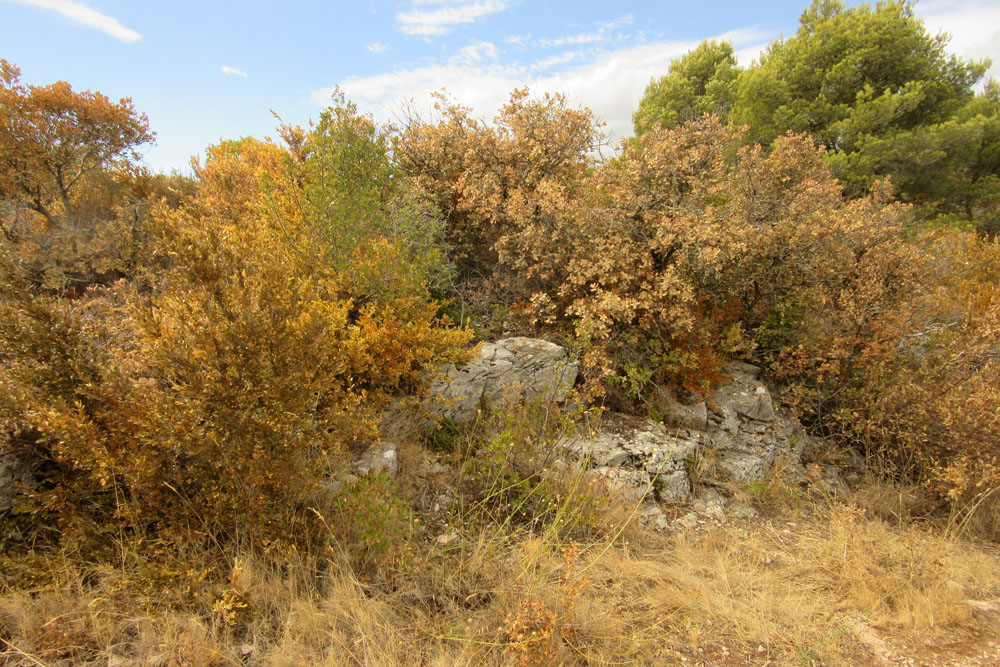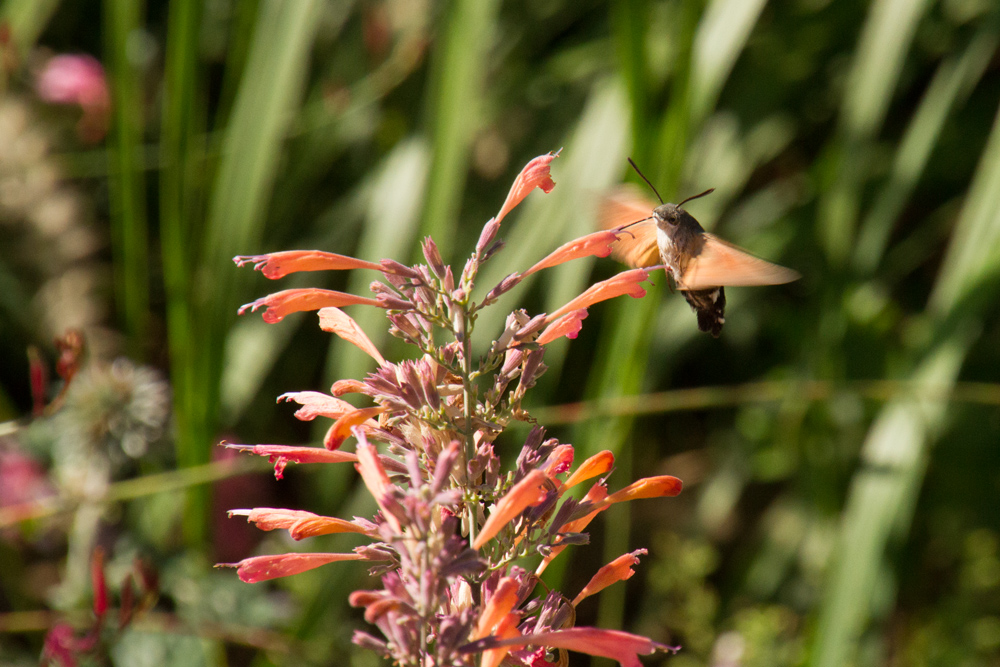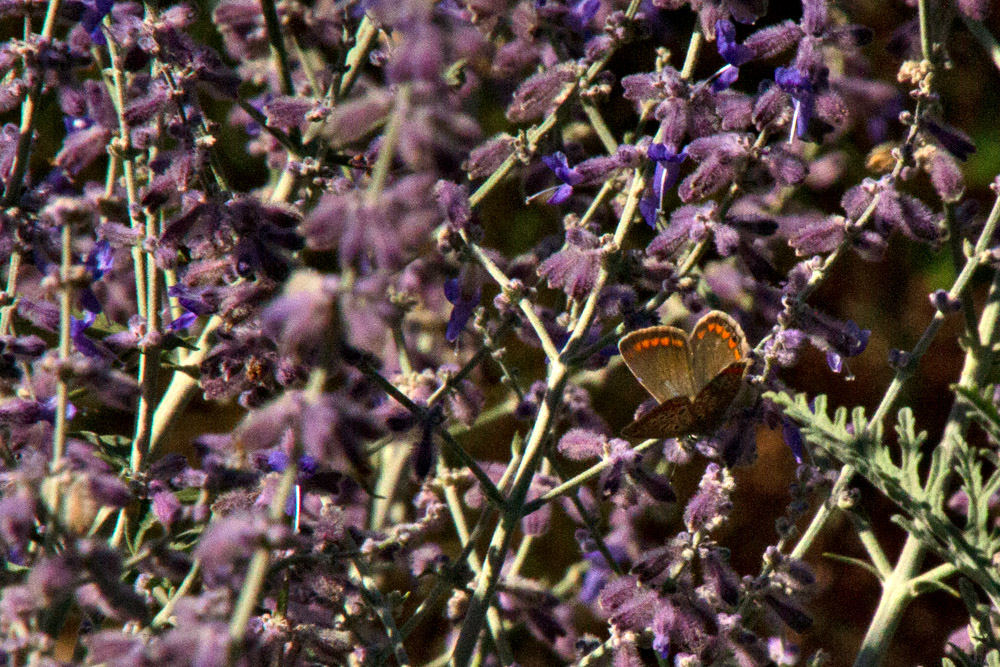September / septembre 2016
Two days in the Aude – gardens, nurseries, a talk on grasses and a country walk
Click on the images to enlarge them / Cliquez sur les images pour les agrandir
It hadn’t rained for months, but for a couple of hours during our journey south-west to Durban-Corbières, several centimetres of water fell out of the sky with ferocious intensity. As a result, on arrival at Le Jardin Botanique we were greeted warmly by our host, Françoise de Gottal, wearing wellington boots due to the large amount of water sitting in puddles everywhere. She was obviously delighted about the rain because the garden was looking very stressed due to a particularly hot and dry summer.
Le Jardin Botanique de Durban-Corbières
was created by a botanist in 1991 on a remote hillside with stunning views.
It was conceived as an educational garden, with a view to teaching local people, school children and tourists about biodiversity and the importance of protecting the environment, and is now managed by a group of volunteers. It contains over 500 varieties of plants, each one beautifully labelled, including the spots where bulbs will appear in spring.
The garden is divided into three parts, ‘la forêt‘, mainly evergreen oak trees,’ la garrigue‘, paths winding through a variety of clipped shrubs and ‘les herbacées‘, open areas where perennials and bulbs had been planted. The poor calcareous clay soil isn’t improved and plants are not watered, so they have to survive (or not) in the natural conditions. The first thing to strike us was the bright orange colour of the box, Buxus sempervirens. Françoise said that this happened frequently in summer and was due to stress, she said the chlorophyll had taken a rest and carotenoids were colouring the leaves.
Françoise seemed confident that the orange plants would become green again and we certainly hoped that she is right as we saw lots more of these bright orange shrubs as we travelled through the countryside.
Winding paths through the garrigue section took us past lentisk, rosemary, cistus, phillyrea, bupleurum, juniper, cedars, ostriya and viburnum.
In the open areas were low-growing thyme, teucrium, dorycnium, origanum and salvias and a rather smart insect hotel (see Wildlife section below). Although many of the plants were taking their summer rest and there were almost no flowers, the garden was still full of interest. However, this September visit did make us want to come back in the late spring when the bulbs and the cistus would be at their best and fill the garden with colour.
La Petite Pépinière
The following morning, we gathered at La Petite Pépinière for a talk on the selection, cultivation and propagation of grasses.
Gill Pound has for many years been interested in growing grasses and seven years ago she decided to dedicate a space in her garden in Caunes-Minervois to experiment with different families of grasses, in order to assess their tolerance to the local Mediterranean climate. The garden has alluvial, reasonably rich, free draining, river soil and plants have to cope with hot dry summers and some quite cold periods in winter.
Gill explained that grasses fall into two main groups: ‘cool season’ grasses that tend to be evergreen and flower in spring and early summer and ‘warm season’ grasses that flower from late summer into autumn. The latter need summer temperatures from 22°C – 28°C to do well.
She said that grasses are generally low maintenance, though most need a heavy cut back in early spring. There is a large choice of different species which can create interest throughout the year, and in particular they provide foliage and textural interest in autumn and winter.
Grasses can look particularly striking in the early morning and evening as low sunshine highlights their colours and textures, their tall stems sway in the wind and morning frosts can give a sculptural appeal.
To create a grass garden from scratch, Gill suggests one should:
- Clear and dig over the selected area then cover ground with Geotex, or similar barrier fabric to prevent weeds from re-appearing.
- Plant three of each variety to create a good impact, cutting away the Geotex to make the planting holes. Arrange the grasses with consideration for their eventual height and width.
- After planting, cover the area with a mulch of gravel, shingle or slates. These inorganic mulches will help keep in moisture during the summer months.
- Water the grasses at least twice in the hot summer months, giving them a good soak with a hose during the evening. This should be sufficient to maintain the grasses in good health.
Some of the most successful grasses in Gill’s garden are:
Pennisetum
Pennisetum villosum, P. orientale ‘Karley Rose’, P. orientale ‘Tall Tails’ and P. alopecuroides
Pennisetum villosum has been used for bordering the grass bed as it creates a dense barrier and helps stop couch grass from creeping into the bed.
Miscanthus
This family of ‘warm season’ grasses needs water to flower well in late summer and early autumn. They form large, tall clumps and need space to look their best. Gill has planted Miscanthus sinensis var. condensatus ‘Cabaret’, M. sinensis var. condensatus ‘Cosmopolitan’, M. sinensis ‘Morning Light’, M. sinensis ‘Gracillimus’, M. sinensis ‘Yaku Jima’, M. sinensis ‘Zebrinus’, M. sinensis ‘Silberfeder’, M. sinensis ‘Dronning Ingrid’, M. sinensis ‘Saturnia’, M. sinensis ’Adagio’, M. sinensis ‘Ferne Osten’ and M. sinensis ‘Kleine Fontäne’. Gill recommended Miscanthus sinensis ‘Yaku Jima’ as very tough and drought tolerant, a real ‘good-doer’ and said that several of the miscanthus family will self-seed well.
Calamagrostis
Calamagrostis x acutiflora ‘Karl Foerster’, C. brachytricha
Eragrostis
Eragrostis spectabilis, E. elliottii and E. curvula
Stipa
All stipas are very drought tolerant. Stipa gigantea is useful for height and its graceful summer and autumn stems. Stipa tenuifolia (syn. S. tenuissima) self-seeds and can be a thug but if you have space it’s a welcome grass to allow to ‘wander at will’.
Ampelodesmos
For height and drama, the most spectacular grass has been Ampelodesmos mauritanicus, a large evergreen clump forming grass with beautiful wands of flowers which need space to be appreciated. It is drought tolerant and grows well in poor soil.
Maintenance and care of a grass collection.
Gill advises that most grasses need some care and maintenance to thrive. The less drought tolerant grasses will need an occasional soak in the summer months. All grasses benefit from a spring tidy- up, either by raking through the low growing evergreen grasses to remove dead growth, or, for the large clump forming grasses such as miscanthus, cutting right back to within a few centimetres of the ground with a hedge cutter or good shears before the new seasons’ growth starts. If grasses such as Pennisetum villosum become a nuisance with their creeping habit, you can simply dig around the edges to reduce the size of the clump and use the excess as new plants for elsewhere.
Good books for further information on grasses:
Designing with Grasses by Neil Lucas (of Knoll Gardens in the UK)
The Color Encyclopedia of Ornamental Grasses by Rick Darke
After the grass garden, Gill took us on to see the latest area in development. The artistically placed pile of stones is designed to be a reptile shelter and around it the ground is being prepared for planting Mediterranean natives.
Le Jardin Champêtre
We then moved on to Le Jardin Champêtre, a new garden and nursery set up in 2015 by Imogen Checketts and Kate Dumbleton, professional horticulturalists from the UK who are now based in Caunes-Minervois. Kate and Imogen talked to us about their progress so far, then showed us around the developing garden.
For the shade garden they started by creating a wide, shallow bowl and made sure the soil was loose and friable. Plants which have thrived include, asters, agastache, Geranium ‘Rosanne’ and Calamagrostis brachytricha.
A large, oval bed in full sun had only been planted six months ago but already the plants had put on an impressive amount of growth.
Kate also showed us the newly planted ground cover bed where they are experimenting with shearing certain plants to keep them close to the ground.
In one corner, Kate and Imogen have installed a beautiful terracotta beehive which, with all the nectar-producing flowers in the garden, should provide a home for lots of bees. After our garden tour we had a delicious ‘pique-nique champêtre’ made by Kate and Imogen, then filled our boots with lots of lovely plants from the nursery.
After lunch it was time for what had been planned as a wild flower walk. However, due to the lack of rain and the fact there would therefore not be any flowers, Gill decided to focus on how the flora of the region had responded to the long period of drought. We followed a path through La carrière du Roy and it was clear that many plants were suffering badly, particularly Buxus sempervirens and Bupleurum fruticosum.
However, several shrubs had not turned brown, including Rhamnus alaternus, Phillyrea angustifolia, Viburnum tinus, Juniperus phoenicea and Pistacia terebinthus. Acer monspessulanum, the Mediterranean maple tree, was also holding up well and in a shady corner under some pine trees, Gill spotted a tiny, but healthy, Teucrium chamaedryoides.
Minervois wildlife
Lots of wildlife interest in all the places that we visited on this trip. At the Jardin Botanique, the torrential rain earlier in the day meant that birds and insects were keeping their heads down but in compensation there was Françoise’s splendid insect hotel – an entomological Ritz which showed every sign of being well occupied.
Gill’s garden has long been an LPO refuge but, at first sight, her latest addition in this regard looked like something from Tate Modern. It is, in fact, a reptile residence, built for Gill by a local enthusiast. There are gaps beneath the slabs where the snakes can sleep and flat surfaces on top where they can take in the warmth, the local dark stone maximising the heat.
Plenty of birds around. At this time of year, the post-nuptial migration is almost at an end but there were groups of straggler migrants around, stuffing themselves with insects and berries before moving on to Spain and beyond. Pied Flycatchers flitted in and out of the trees across the river and Crag Martins swooped overhead. There were residents too, like the Collared Doves that glided from treetop to treetop and later a Black Redstart, not much bothered by humans, that showed up at lunchtime chez Imogen and Kate.
The late flowers were attracting many insects although these ants seemed more interested in the seeds of Verbena bonariensis, digging them out before trundling off in a long convoy down the plant stem.
Verbena bonariensis was also of great interest to a Bee-fly which, as its name suggests, has a furry body like a bee; it also shares a bee’s nectar habit – sitting on the flower itself or hovering nearby and using its long proboscis to drink. Just like this Hummingbird Hawkmoth in fact.
Kate and Imogen’s place was full of butterflies and, among the Pierids, it was good to see both Large and Green-veined Whites as well as the omnipresent Small ones.
There are dozens of species of blue butterflies which this observer has great difficulty in sorting out (especially as the females tend to be brown). Usually they all turn out to be Common Blues but on this occasion there was also a Chalkhill Blue and a Long-tailed Blue.
Finally, there was Cattus bibliothecus ssp. botanicus.
Text: Catriona McLean, Christine Daniels and Ian Davis
Photos: Hilary Ivey, Christine Daniels and Ian Davis
![]()




















































